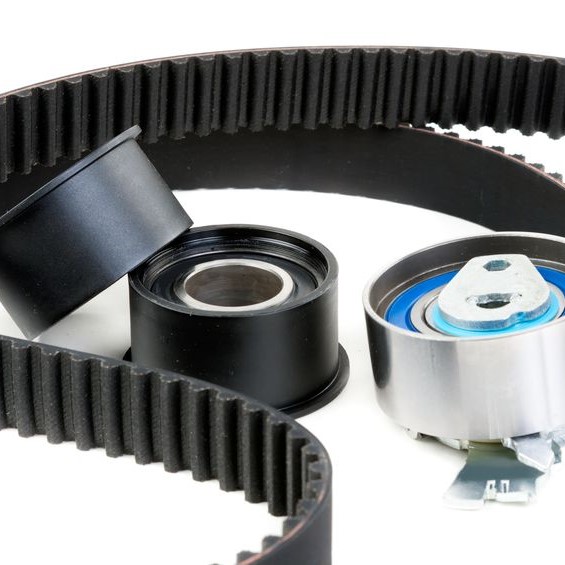
Signs of a bad timing belt
In older cars, there was a timing chain and looked something like a chain. Today, it is a timing belt made of rubber. When the timing belt breaks or gets off kilter, a timing belt replacement is necessary, or your car won’t move. Why is the timing so important?
It is an important component of your car’s operation as it is what synchronizes the function of two other important components: the camshaft and the crankshaft. The camshaft works the valves that lets the air and gas in and out of the engine. The crankshaft operates the pistons to go up and down. Both of these have to work in synchronized method, or it can damage, even destroy the engine. The timing belt keeps them in synchronization of perfect timing. So, when the timing belt is broke or off kilter, a timing belt replacement is a must, or your car won’t be going anywhere.
How do I know if my timing belt is worn out?
The timing belt isn’t where you can visually see it as soon as you open the hood, it is located close to the engine’s front end. There isn’t a warning light on the dashboard of your car that tells you a timing belt replacement is needed. However, there are some symptoms that will tell you that your car needs a timing belt replacement:
Ticking Noise
A car engine is something like the human body. The knee bone is connected to the thigh bone, and the timing belt is attached to the engine with a series of pulleys. Those pulleys operate the camshaft and crankshaft, and the crankshaft powers works the rods, the rods work the pistons. The camshaft works the cylinder head valve and rocker arms, to send fuel to the combustion chamber. The ejected gases pass through the exhaust manifold. So, when the timing belt begins to weaken or breaks, a ticking noise is heard from inside the engine. A clicking sound also comes from the engine when it is low on oil. In either case, immediate attention is needed by a mechanic who will add oil to the engine or determine if a timing belt replacement is needed.
Engine Won’t Start
When a timing belt is broken, the engine can’t turn and start. This is discovered when you insert the key to start the motor, you’ll hear it engage, but it doesn’t crank. That is because the camshaft and crankshaft can’t engage the pistons and get the fuel to the engine. It is possible for your timing belt to break while driving it too. You won’t be able to drive your car until you have a timing belt replacement job, and there is a chance that more damage has been done to the motor that the timing belt replacement isn’t enough.
Oil Leak
An oil leak from the engine can be a symptom of a few things, one of them is the timing belt has broken or is worn out. There are bolts and nuts on the timing belt cover that hold it in place, protecting the timing belt. When the timing belt has begun to wear out, oil will begin leaking around those bolts and nuts. Fortunately, a timing belt replacement will usually fix that problem. However, an oil leak from the engine block indicates more serious engine problems.
The Exhaust
If there is more smoke coming from your car’s tail pipe than normal, that can be an indication that a time belt replacement is necessary. As soon as you notice excessive amount of exhaust, have your mechanic inspect the engine. Finding the problem sooner than later could be the difference of hundreds to thousands of dollars.
RPMs Acting Up
If the RPMs of your car are acting strange, it could be because of a bad timing belt. It could have broken teeth, or it has completely broken.
What does a bad timing belt sound like?
A timing belt that is wearing out, where some of the teeth have worn down on the rubber belt, will cause a ticking noise. The sound will sound like it is coming from the engine front, which can often sound like a rod knocking. An experienced mechanic check the oil first to make sure that isn’t the problem, then check to see if a timing belt replacement is necessary.
When a timing belt breaks, the engine will create a whining noise when you try to start the motor. This is because the pulleys the timing belt works the camshaft and crankshaft are spinning with no belt resistance.
Can you drive with a bad timing belt?
You can’t put off a timing belt replacement until it is more convenient. If your car won’t start, it could be the alternator, battery, out of gas, or the timing belt is bad or broken. If the timing belt is wearing out, your car will start and run, until it breaks as you’re driving down the road. This is why you need to be aware of the indicators we listed above so that you know to get your car inspected by a mechanic.
How often do you have to replace a timing belt?
Timing belt replacement miles or years aren’t the same for every car because everyone has different driving patterns, however, regular timing belt replacement between 60,000 miles and 100,000 miles is recommended. Using the services of the same mechanic will help them learn your driving patterns and their timing belt replacement recommendations could be every 50,000 miles or every 100,000 miles. If you put a lot of miles on your car in a short time, your car will benefit from a timing belt replacement sooner.

What does a timing belt replacement cost?
What is timing belt replacement cost can depend on the year, make, and model of your car. The average expense starts around $300 and can go as high as $700 or more. There is a lot of work involved in removing the broken timing belt and other tasks that take place before the timing belt replacement is done. A high end car, the timing belt replacement can cost upward of $1,000. Call 941-493-6511 today for timing belt service in Venice, FL.


